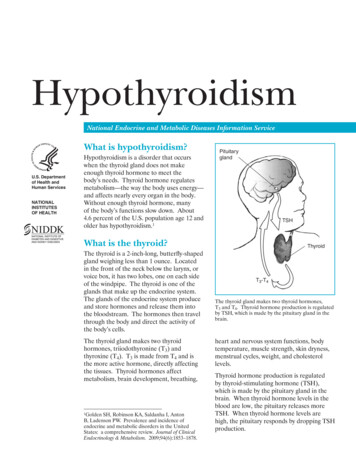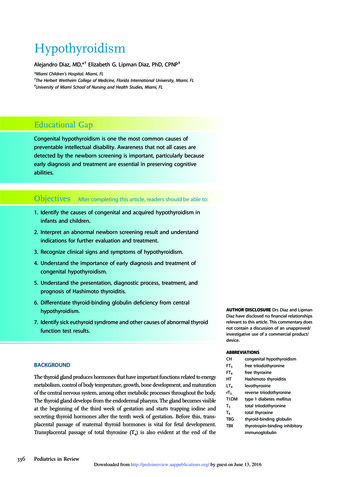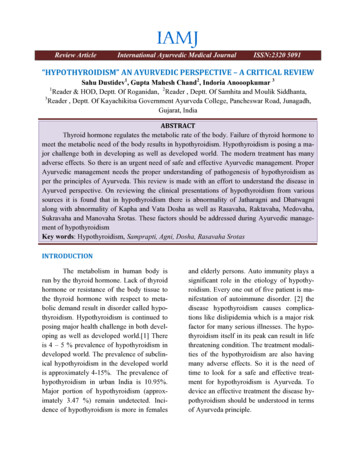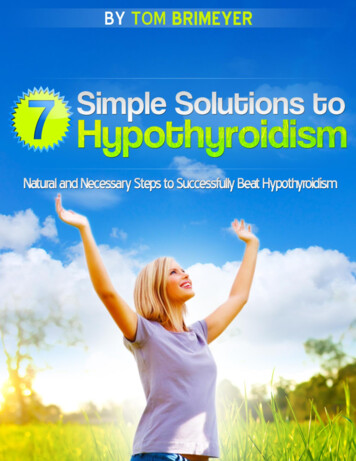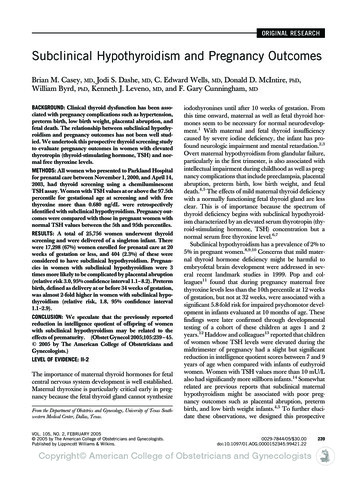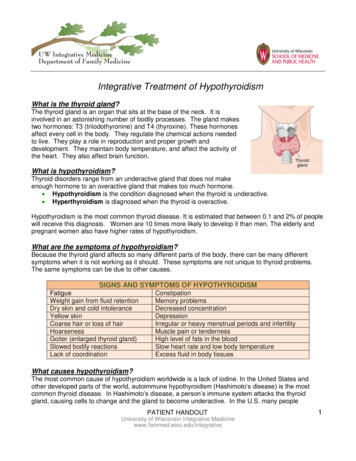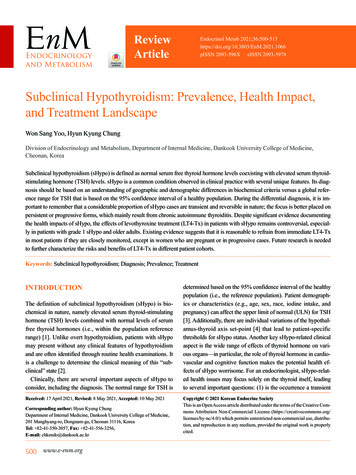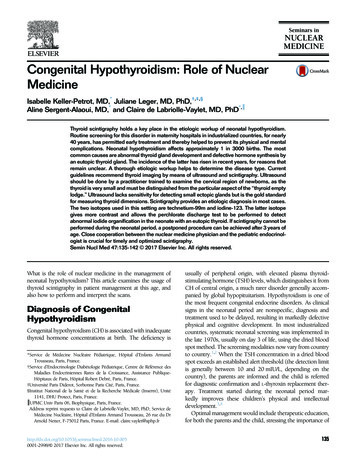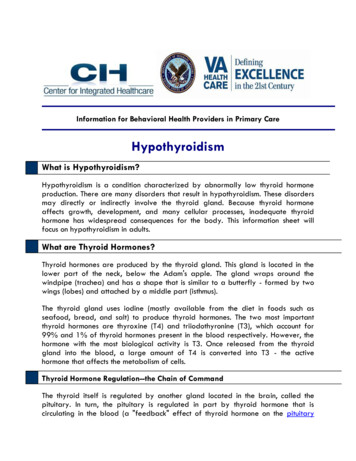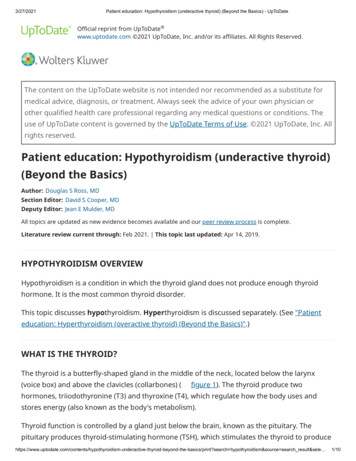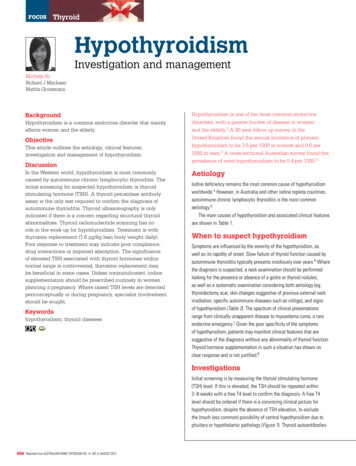
Transcription
ThyroidHypothyroidismInvestigation and managementMichelle SoRichard J MacIsaacMathis GrossmannBackgroundHypothyroidism is a common endocrine disorder that mainlyaffects women and the elderly.ObjectiveThis article outlines the aetiology, clinical features,investigation and management of hypothyroidism.DiscussionIn the Western world, hypothyroidism is most commonlycaused by autoimmune chronic lymphocytic thyroiditis. Theinitial screening for suspected hypothyroidism is thyroidstimulating hormone (TSH). A thyroid peroxidase antibodyassay is the only test required to confirm the diagnosis ofautoimmune thyroiditis. Thyroid ultrasonography is onlyindicated if there is a concern regarding structural thyroidabnormalities. Thyroid radionucleotide scanning has norole in the work-up for hypothyroidism. Treatment is withthyroxine replacement (1.6 µg/kg lean body weight daily).Poor response to treatment may indicate poor compliance,drug interactions or impaired absorption. The significanceof elevated TSH associated with thyroid hormones withinnormal range is controversial; thyroxine replacement maybe beneficial in some cases. Unless contraindicated, iodinesupplementation should be prescribed routinely in womenplanning a pregnancy. Where raised TSH levels are detectedpericonceptually or during pregnancy, specialist involvementshould be sought.Keywordshypothyroidism; thyroid diseasesHypothyroidism is one of the most common endocrinedisorders, with a greater burden of disease in womenand the elderly.1 A 20 year follow up survey in theUnited Kingdom found the annual incidence of primaryhypothyroidism to be 3.5 per 1000 in women and 0.6 per1000 in men.2 A cross sectional Australian survey found theprevalence of overt hypothyroidism to be 5.4 per 1000.3AetiologyIodine deficiency remains the most common cause of hypothyroidismworldwide.4 However, in Australia and other iodine replete countries,autoimmune chronic lymphocytic thyroiditis is the most commonaetiology.5The main causes of hypothyroidism and associated clinical featuresare shown in Table 1.When to suspect hypothyroidismSymptoms are influenced by the severity of the hypothyroidism, aswell as its rapidity of onset. Slow failure of thyroid function caused byautoimmune thyroiditis typically presents insidiously over years.6 Wherethe diagnosis is suspected, a neck examination should be performedlooking for the presence or absence of a goitre or thyroid nodules,as well as a systematic examination considering both aetiology (eg.thyroidectomy scar, skin changes suggestive of previous external neckirradiation, specific autoimmune diseases such as vitiligo), and signsof hypothyroidism (Table 2). The spectrum of clinical presentationsrange from clinically unapparent disease to myxoedema coma, a rareendocrine emergency.7 Given the poor specificity of the symptomsof hypothyroidism, patients may manifest clinical features that aresuggestive of the diagnosis without any abnormality of thyroid function.Thyroid hormone supplementation in such a situation has shown noclear response and is not justified.8InvestigationsInitial screening is by measuring the thyroid stimulating hormone(TSH) level. If this is elevated, the TSH should be repeated within2–8 weeks with a free T4 level to confirm the diagnosis. A free T4level should be ordered if there is a convincing clinical picture forhypothyroidism, despite the absence of TSH elevation, to excludethe (much less common) possibility of central hypothyroidism due topituitary or hypothalamic pathology (Figure 1). Thyroid autoantibodies556 Reprinted from Australian Family Physician Vol. 41, No. 8, august 2012
Table 1. Causes of hypothyroidism and associated clinical featuresCauseClinical features to elicitAutoimmune lymphocytic thyroiditis Hashimoto thyroiditis Atrophic thyroiditisPersonal or family history of autoimmune conditions.Evidence of specific autoimmune diseases such as vitiligoon examinationPostablative therapy or surgery Radioiodine therapy ThyroidectomyHistory of previous radioiodine therapy or thyroid surgeryEvidence of a surgical scar or skin changes suggestive ofprevious external neck irradiation on examinationTransient Subacute thyroiditis Silent thyroiditis Postpartum thyroiditis Early postablative therapyPreceding history of viral infection, pregnancy or radioiodineablationEvidence of an enlarged tender thyroid on examination(subacute thyroiditis)Iodine associated Iodine deficiency Iodine inducedDietary intake historyDrug induced Carbimazole Propylthiouracil Iodine Amiodarone Lithium Interferons Thalidomide Sunitinib RifampicinMedication historyInfiltrative Riedel thyroiditis (fibrous thyroiditis) Scleroderma Amyloid disease Haemochromatosis Infection (eg. tuberculosis)Personal history or other systemic features of an infiltrativedisorderNeonatal/congenital Thyroid agenesis/ectopia Genetic disorders affecting thyroid hormone synthesis Transplacental passage of TSH receptor blockingantibodyFamily history of thyroid disease/hypothyroidismMaternal medication use during pregnancyRare Secondary (pituitary or hypothalamic disease) Thyroid hormone resistance syndrome Anomalous laboratory TSH results (eg. caused byheterophil antibodies)Other clinical features of pituitary deficiency(antithyroid peroxidase and antithyroglobulin antibodies) are positive in95% of patients with autoimmune thyroiditis. The thyroid peroxidase(TPO) antibody assay is sufficiently sensitive and specific to makethis the only test now needed to confirm a diagnosis of autoimmunethyroiditis.5 Antithyroglobulin antibodies are nonspecific and theuse of this test is now confined to thyroid cancer follow up. Thyroidperoxidase antibody positivity is seen in 10–15% of the generalpopulation2,3,9 and is not an indication for treatment where there is nobiochemical abnormality of thyroid function. Annual thyroid functiontesting is recommended in euthyroid patients who have positiveantithyroid antibodies, as progression to hypothyroidism is morecommon in this patient group.2A diagnosis of hypothyroidism in itself is not an indication forthyroid imaging. Thyroid ultrasonography is only indicated to evaluatesuspicious structural thyroid abnormalities (ie. palpable thyroid nodules).While thyroid radionucleotide scanning may be useful in elucidatingthe aetiology of hyperthyroidism, it has no role in the work-up forhypothyroidism. There is an association between chronic thyroiditis andReprinted from Australian Family Physician Vol. 41, No. 8, august 2012 557
FOCUS Hypothyroidism – investigation and managementthyroid nodules, but whether this association is related to an increasedrisk of thyroid cancer is controversial.7A low serum T4 without the expected increase in serum TSHraises the possibility of central hypothyroidism due to pituitary orhypothalamic pathology (Figure 1). However, as this pattern is alsoseen transiently during recovery from severe illness, it should beconfirmed on a repeat test when the patient is well. Clinical cluesfor central hypothyroidism include other features of pituitary failure(eg. amenorrhoea, hypotension, fine wrinkling of the skin, abnormalTable 2. Symptoms, signs and additionalinvestigation findings in hypothyroidismOrgan systemSymptoms and signsAppearance Puffy and pale faciesDry, brittle hairSparse eyebrowsDry, cool skinThickened and brittle nailsMyxoedema – fluid infiltration oftissuesEnergy andnutrientmetabolism Cold intolerance Weight gain FatigueNervous system Headache Paraesthesias (including carpaltunnel syndrome) Cerebellar ataxia Delayed relaxation of deep tendonreflexesCognitive/psychiatric Reduced attention span Memory deficits DepressionCardiovascular Musculoskeletal Myalgias ArthralgiasGastrointestinal Anorexia ConstipationReproductivesystem Irregular or heavy menses InfertilityBradycardiaDiastolic hypertensionPericardial effusionDecreased exercise toleranceAdditional investigations Hypercholesterolaemia*Mild anaemiaHyponatraemiaRaised creatinine kinase†* Patients with unexplained hypercholesterolaemia mayhave undiagnosed hypothyroidism† Statin therapy in hypothyroid patients increases therisk of rhabdomyolysis and should be avoidedAdapted from www.thyroidmanager.org558 Reprinted from Australian Family Physician Vol. 41, No. 8, august 2012pallor, hyponatraemia or hypoglycaemia) or features suggestive of apituitary mass lesion (eg. visual impairment or headache).8 If centralhypothyroidism is suspected, the function of the hypothalamicpituitary-adrenal axis should be tested and a magnetic resonanceimaging (MRI) scan of the pituitary gland obtained.10 Importantly,if there is associated secondary adrenal failure, thyroid hormonesupplementation should only be commenced after glucocorticoidreplacement, otherwise an adrenal crisis may be precipitated.11ManagementThyoxine replacement therapy is the mainstay of treatment forhypothyroidism and is usually lifelong. However, it is important torecognise when the cause of the hypothyroidism is transient or druginduced because this may require no treatment or only short termthyroxine supplementation (Table 1).DosingThe average daily dose of thyroxine is 1.6 µg per kilogram body weight.However, lower initial doses should be considered in patients whoare elderly, frail or who have symptomatic angina, as thyroid hormoneincreases myocardial oxygen demand with the risk of inducing anginaor a myocardial infarction. An initial dose of 50 µg/day is appropriatefor healthy elderly patients and 25 µg/day or 12.5 µg/day for the veryfrail and those with symptomatic angina.10Typically, thyroxine is administered on a daily basis. However,due to its half life of approximately 1 week, weekly administration isoccasionally an option where compliance is an issue. Its long half lifealso means dosing should be adjusted at an interval of no less than6–8 weeks to allow a steady state to be achieved.12 An appropriateinitial target is the relief of symptoms (if present) and a serum TSHwithin the laboratory range. In patients with persistent symptoms of illhealth, then further titration of thyroxine dosage aiming for a TSH levelin the lower reference range (eg. 0.4–2.5 mIU/L) is reasonable. A TSHlevel in the upper half of the reference range is usually acceptable inolder persons. Lower TSH targets may be adopted in pregnancy, and inHigh TSHLow T4PrimaryhypothyroidismNormal T4SubclinicalhypothyroidismNormal TSHLow T4 Secondaryhypothyroidism (pituitary orhypothalamus) Severe nonthyroidalillnessFigure 1. Interpretation of hypothyroid function testresults
Hypothyroidism – investigation and management FOCUSpatients with thyroid cancer, and specialist advice should be sought inthese cases (Table 3). In secondary hypothyroidism, TSH is unreliable,and thyroxine dose is adjusted according to free T4 levels, whichshould be in the mid to normal range.5The thyroxine dose should be increased by 12.5–25 µg/day if theTSH remains above target. In Australia, levothyroxine (LT4) tablets areavailable in 50, 75, 100 and 200 µg preparations. A practical approachto adjusting thyroxine dosages without cutting tablets would be touse alternate day dosing or to vary the dose depending on the day ofthe week8 (eg. Monday to Friday 100 µg with 200 µg on weekends).Once the TSH has normalised, the frequency of review can be reducedto 6 months and then annually thereafter, unless there are situationsthat may alter thyroxine requirements (eg. significant weight change,commencement of a proton pump inhibitor or the oral contraceptivepill, or plans for pregnancy).Side effectsTreatment side effects are rare when the correct dose is given.Fatigue, increased appetite, diarrhoea, nervousness, palpitations,insomnia and tremors are indicative of overtreatment.13 Thesesymptoms should prompt a repeat TSH level and if suppressed,a reduction in dose of thyroxine. A true allergic reaction to theactive ingredient of standard levothyroxine tablets is rare andspecialist advice should be sought where alternative therapy (ie.triiodothyronine) is being considered.Table 3. AACE* guidelines for indications forreferral to a specialist in cases of hypothyroidism7 Patients aged 18 years or less Patients unresponsive to therapy Pregnant patients Cardiac patients Presence of goitre, nodule, or other structural changesin the thyroid gland Presence of other endocrine disease* American Association of Clinical EndocrinologistsPatients should be instructed to take their thyroxine on an emptystomach, at least half an hour before other drugs (this includesespresso coffee).16 Medicines that may increase thyroxinerequirements include:15 the oral contraceptive pill anti-epileptic medication (eg. carbamazepine, phenytoin) some antibiotics (eg. rifampicin) the new tyrosine kinase inhibitors (eg. imatinib).AbsorptionThere are a few factors to be considered where biochemical orsymptomatic correction is not achieved despite adequate thyroxinedosing. These include compliance, drug interactions and absorption.Much of the variability in replacement thyroxine doses betweenindividuals, after adjustment for body weight, is derived from differencesin efficiency of gastrointestinal absorption. Malabsorptive conditions mayaffect the percentage of the ingested thyroxine dose absorbed and thusincrease the required dose. These conditions include small bowel bypass,inflammatory bowel disease, coeliac disease and lactose intolerance. Inaddition, Helicobacter pylori infection and associated chronic gastritishas been found to impair thyroxine absorption. This may improve withtreatment of the H. pylori infection with combination therapy.15CompliancePersistent symptomsPoor compliance is one of the most common reasons for failure toachieve euthyroidism, despite the prescription of otherwise adequatedoses of thyroxine.14 Occasionally, where a patient has beennoncompliant for a period of time and takes a large dose of thyroxinebefore their blood test it results in a pattern of TSH elevation withhigh to normal or elevated free T4.10 In these cases it is important toreview the frequency of missed tablets with the patient and discussthe importance of treatment compliance.14Symptoms compatible with hypothyroidism may occasionally persist witha TSH level within normal range. In some cases, further dose adjustmentto achieve a TSH level in the lower reference range (around 1 mIU/L)may provide symptom resolution.17,18 However, in a controlled WesternAustralian trial of escalating doses of thyroxine therapy, there were nodifferences in measures of wellbeing or quality of life between patientswho achieved a TSH target of 0.3, 1.0 or 2.8 mIU/L, respectively.19In addition, TSH levels of 0.4 mIU/L have been associated withosteoporosis and atrial fibrillation in people over 60 years of age.20Persistent symptoms with low normal TSH levels should prompt asearch for other causes such as sleep apnoea, pernicious anaemia ordepression. If there is a clear worsening with commencing or increasingthyroxine, co-existing Addison disease should be considered.11Levothyroxine is the preferred way to replace thyroid hormone,and a meta-analysis of 11 randomised studies with more than 1000patients has shown no obvious benefit of combined levothyroxine andtriiodothyronine (T3) therapy.21 Desiccated thyroid or thyroid hormoneextracts, marketed as ‘bioidentical hormones’ are not a pure product,not approved by the Therapeutic Goods Administration, and haveAddressing poor response to treatmentDrug interactionsThere are a number of drugs that increase thyroxine requirementseither by reducing absorption or increasing metabolism. Drugs thathave been shown to reduce absorption include:15 calcium carbonate ferrous sulphate multivitamins cholestyramine phosphate binders proton pump inhibitors.Reprinted from Australian Family Physician Vol. 41, No. 8, august 2012 559
FOCUS Hypothyroidism – investigation and managementlimited quality control. A recent Endocrine Society of Australia positionstatement has therefore concluded that, ‘in general, desiccated thyroidhormone or thyroid extract, combinations of thyroid hormones ortriiodothyronine should not be used as thyroid replacement therapy’.22Pregnancy and hypothyroidismUnless contraindicated, iodine supplementation should be prescribedroutinely in women planning a pregnancy. The National Health andMedical Research Council recommends an iodine supplement of150 µg each day.23 Maternal thyroid function during pregnancy changesin response to the increased metabolic requirements and the presence ofthe fetus. In addition, thyrotropic activity of β-hCG results in a decreasein TSH in the first trimester.24 To reflect this adaptation, trimester specificreference intervals for thyroid function tests are recommended.25If laboratory reference ranges are not available, the following rangeshave been provided by the American Thyroid Association:24 first trimester 0.1–2.5 mIU/L second trimester 0.2–3.0 mIU/L third trimester 0.3–3.0 mIU/L.In general, involvement of a specialist is required for the managementof raised TSH levels with 4 weekly thyroid function monitoring to20 weeks gestation, with less frequent monitoring thereafter.24 Thekey features of managing hypothyroidism/raised TSH levels duringpregnancy are summarised in Table 4. There is no clear evidence torecommend population screening with TSH of pregnant women, or ofwomen desiring pregnancy, in the absence of suggestive symptoms orof risk factors for thyroid disease.24Subclinical hypothyroidism innonpregnant adultsSubclinical hypothyroidism is defined as a persistently elevated serumTSH with thyroid hormone levels within the reference range. Thispattern of thyroid function tests has raised considerable controversyregarding clinical significance and optimum mode of management.26Subclinical hypothyroidism is detected in 4–8% of the generalpopulation and in up to 15–18% of women aged more than 60 years.27Approximately 4–18% of patients will progress to overt hypothyroidismeach year with an increased risk with the following factors:10Table 4. Definition and management of a raised TSH/hypothyroidism during pregnancyDefinitionConcernRecommended 5%)TSH 2.5 with lowT4 or TSH 10irrespective of T4levelConsistent evidence that OH isassociated with adverse pregnancyoutcomes29,30 and impaired fetalneurocognitive development31Treatment of OH withlevothyroxine is recommended.The goal is to normalise maternalserum TSH values within thetrimester specific pregnancyreference range. Commencementof thyroxine while awaitingspecialist review is generallyappropriate (eg. 50–100 –2.5%)TSH between2.5–10 with normalT4 levelsEvidence is variable as to the effect ofSCH on pregnancy and the fetusAt this stage, the associated risk ofobstetric complications has been moreclearly demonstrated than the risk ofneurocognitive deficits in the fetus. Inaddition, TPO Ab positivity may in itselfbe associated with fetal miscarriageand levothyroxone intervention in TPOantibody positive women with SCH maybe beneficial32Options include treatmentwith levothyroxine to normalisematernal serum TSH or 4 weeklymonitoring of TSHObtain TPO Ab levels whileawaiting specialist reviewKnown history ofhypothyroidismHistory ofhypothyroidism onthyroxine beforepregnancyNormal self regulatory increase inendogenous T4, especially throughoutthe first trimester, is not achieved by thedysfunctional thyroid gland33Levothyroxine adjustment shouldbe made as soon as pregnancy isconfirmedAim to normalise TSH levels(ie. TSH 2.5) by increasinglevothyroxine by two additionaltablets weekly or by 25–30% andmonitor thyroid function test4 weeklyThis adjustment can also bemade preconception in womenplanning pregnancy560 Reprinted from Australian Family Physician Vol. 41, No. 8, august 2012
Hypothyroidism – investigation and management FOCUS presence of antithyroid antibodies (twofold increase in risk)presence of a goitremore pronounced TSH elevationhistory of radioiodine ablation therapy, external radiation therapyand chronic lithium therapy.Where the TSH is between 5–10 mIU/L and there is the presenceof anti-TPO antibodies, or a goitre, an alternative option to thyroxinetherapy would be annual thyroid function tests for early detection ofprogression to frank hypothyroidism. In contrast, where the patientis antithyroid antibody negative, 3 yearly thyroid function tests areconsidered sufficient.28 An algorithm for the management of subclinicalhypothyroidism in the nonpregnant adult is shown in Figure 2.Where treatment is commenced, an initial dose oflevothyroxine of 25–50 µg/day can be used with a target TSHlevel between 1.0 and 3.0 mIU/L. The TSH level should bemeasured in 6–8 weeks after commencement of therapy, andannual reviews once the TSH level is stable.6The controversyThe significance and hence the benefits of treating subclinicalhypothyroidism remains controversial. Potential risks of nottreating subclinical hypothyroidism include progression to overthypothyroidism, cardiovascular effects, dyslipidaemia andneuropsychiatric effects.7,8,27 A recent Cochrane review27 found thatthyroxine versus no treatment for subclinical hypothyroidism did notimprove overall survival, cardiovascular morbidity, health relatedquality of life or symptoms ascribed to subclinical hypothyroidism.However, there was some evidence to suggest that thyroxinereplacement improved surrogate markers for cardiovascular diseasesuch as lipid profile, vascular compliance and left ventricularfunction.Key points Iodine deficiency is the most common cause of hypothyroidismworldwide. Autoimmune chronic lymphocytic thyroiditis is themost common aetiology in iodine replete countries such asAustralia. Initial screening for patients with suspected hypothyroidism isperformed by measuring the TSH level. A positive thyroid peroxidase antibody assay confirmsautoimmune thyroiditis as the cause. Thyroid ultrasonography is only indicated to evaluate suspiciousstructural thyroid abnormalities (ie. palpable thyroid nodules). Treatment is with thyroxine replacement (1.6 µg/kg lean bodyweight daily).Recommended managementLevothyroxine therapy is usually recommended where the serum TSHis greater than 10 mIU/L.7 Where the TSH is consistently between5–10 mIU/L and the patient is symptomatic, a 3–6 month trial oflevothyroxine replacement is appropriate. Treatment can be continuedwhere there is symptomatic benefit.28Elevated TSH and normal thyroid hormone levelsTSH 10 mIU/LTSH 5–10 mIU/LCheck TPOantibodySymptoms ofhypothyroidism3–6 month trial oflevothyroxine therapy withcontinuation if symptombenefitTreat with yroxinetherapy or annualthyroid functiontests, depending onpatient preferenceThyroid functiontests every 3 yearsFigure 2. Algorithm for management of subclinical hypothyroidism in the nonpregnant adultAdapted from Vaidya B, Pearce SHS. Management of hypothyroidism in adults. BMJ 2008;337:284–9.Reprinted from Australian Family Physician Vol. 41, No. 8, august 2012 561
FOCUS Hypothyroidism – investigation and management Poor response to treatment may indicate poor compliance, druginteractions or impaired absorption. Thyroxine replacement may be beneficial in some cases ofelevated TSH associated with normal thyroid hormone levels,however, this remains controversial. Unless contraindicated, iodine supplementation should beprescribed routinely in women planning a pregnancy.Resources T hyroid Disease Manager is an online, regularly updated resourcethat includes chapters on all aspects of thyroid disorders from pathophysiology through to management: www.thyroidmanager.org The American Thyroid Association provides clinical and scientificresources for health professionals in addition to patient educationalbrochures and programs: www.thyroid.org The Endocrine Society of Australia position statement on desiccatedthyroid or thyroid extract: www.endocrinesociety.org.au.AuthorsMichelle So MBBS, BMedSc, DipObs, is an endocrinology advancedtrainee, Austin Health and Northern Health, Melbourne, Victoria.mjmso@yahoo.comRichard J MacIsaac BSc(Hons), PhD, MBBS, FRACP, is Professor andDirector of Endocrinology, Department of Endocrinology & Diabetes, StVincent’s Health, Professorial Fellow, The University of Melbourne andSenior Principal Research Associate, St Vincent’s Institute of MedicalResearch, Melbourne, Victoria13.14.15.16.17.18.19.20.21.22.23.Mathis Grossmann MD, PhD, FRACP, is consultant endocrinologist, Department of Endocrinology and Diabetes, Austin Health andPrincipal Research Fellow, Department of Medicine, Austin Health, TheUniversity of Melbourne, Victoria.24.Conflict of interest: none declared.26.References27.Canaris GJ, Manowitz NR, Mayor G, Ridgway EC. The Colorado thyroiddisease prevalence study. Arch Intern Med 2000;28:526–34.2. Vanderpump MP, Tunbridge WM, French JM, et al. The incidence of thyroiddisorders in the community: a twenty-year follow-up of the WhickhamSurvey. Clin Endocrinol (Oxf) 1995;43:55–68.3. O’Leary PC, Feddema PH, Valdo PM, et al. Investigations of thyroid hormones and antibodies based on a community health survey: the Busseltonthyroid study. Clin Endocrinol 2006;64:97–104.4. Andersson M, Takkouche B, Egli I, Allen HE, de Benoist B. Current globaliodine status and progress over the last decade towards the elimination ofiodine deficiency. Bull World Health Organ 2005;83:518.5. Topliss DJ, Creswell JE. Diagnosis and management of hyperthyroidismand hypothyroidism. Med J Aust 2004;180:186–93.6. Vaidya B, Pearce SHS. Management of hypothyroidism in adults. BMJ2008;337:284–9.7. American Association of Clinical Endocrinologists. Thyroid GuidelinesCommittee. AACE medical guidelines for clinical practice for the evaluation and treatment of hyperthyroidism and hypothyroidism. Endocr Pract2002;8:457–69.8. Stockigt J. Thyroid disorders. Australian Doctor, 4 February 2005;21–8.9. Preedy VR, Burrow GN, Watson RR, editors. Iodine: nutritional, biochemical, pathological and therapeutic aspects. Oxford: Elsevier, 2009.10. Devdhar M, Ousman YH, Burman KD. Hypothyroidism. Endocrinol MetabClin N Am 2007;36:595–615.11. Murray JS, Jayarajasingh R, Perros P. Deterioration of symptoms after startof thyroid hormone replacement. BMJ 2001;323:332.12. Fish LH, Schwartz HL, Cavanaugh J, Steffes MW, Bangle JP, Oppenheimer25.1.562 Reprinted from Australian Family Physician Vol. 41, No. 8, august 201228.29.30.31.32.33.JH. Replacement dose, metabolism, and bioavailability of levothyroxine inthe treatment of hypothyroidism: role of triiodothyronine in pituitary feedback in humans. N Engl J Med 1987;316:764–70.Rehman HU, Bajwa TA. Newly diagnosed hypothyroidism. BMJ 2004;329:1271.Morris JC. How do you approach the problem of TSH elevation in a patienton high-dose thyroid hormone replacement? Clin Endocrinol 2009;70:671–3.Liwanpo L, Hershman JM. Conditions and drugs interfering with thyroxineabsorption. Best Pract Res Clin Endocrinol Metab 2009;23:781–92.Benvenga S, Bartolene L, Pappalardo MA, et al. Altered intestinal absorption of L-thyroxine caused by coffee. Thyroid 2008;18:293–301.Hollowell JG, Staehling NW, Flanders WD, et al. Serum TSH, T4 andthyroid antibodies in the United States population (1988-1994): NationalHealth and Nutrition Survey (NHANES III). J Clin Endocrinol Metab2002;87:486–8.Saravanan P, Visser TJ, Dayan CM. Psychological well-being correlateswith free thyroxine but not free 3,5,3’-triiodothyronine levels in patients onthyroid hormone replacement. J Clin Endocrinol Metab 2006;91:3389.Walsh JP, Ward LC, Burke V, et al. Small changes in thyroxine dosage donot produce measurable changes in hypothyroid symptoms, well-being,or quality of life: results of a double-blind, randomized clinical trial. J ClinEndocrinol Metab 2006;91:2624–30.Uzzan B, Campos J, Cucherat M, Nony P, Boissel JP, Perret GY. Effects onbone mass of long term treatment with thyroid hormones: a meta-analysis.J Clin Endocrinol Metab 1996;81:4278–89.Grozinsky-Glasberg S, Fraser A, Nahshoni E, Weizman A, Leibovici L.Thyroxine-triiodothyronine combination therapy versus thyroxine monotherapy for clinical hypothyroidism: meta-analysis of randomized controlledtrials. J Clin Endocrinol Metab 2006;91:2592–9.Ebeling PR. ESA position statement on desiccated thyroid or thyroidextract. 2011.Public statement: Iodine supplementation for pregnant and breastfeedingwomen. National Health and Medical Research Council. January, 2010.Stagnaro-Green A, Abalovich M, Alexander E, et al. Guidelines of theAmerican Thyroid Association for the diagnosis and management of thyroiddisease during pregnancy and postpartum. Thyroid 2011;21:1081–125.de Escobar GM, Ares S, Berbel P, Obregón MJ, del Rey FE. The changing role of maternal thyroid hormone in fetal brain development. SeminPerinatol 2008;32:380–6.Pinchera A. Subclinical thyroid disease: to treat or not to treat? Thyroid2005;15:1–2.Villar HCCE, Saconato H, Valente O, Atallah AN. Thyroid hormone replacement for subclinical hypothyroidism. Cochrane Database of Systc Revs2009;1.Vanderpump MPJ. How should we manage patients with mildly increasedserum thyrotrophin concentrations? Clin Endocrinol 2010;72:436–40.Allan WC, Haddow JE, Palomaki GE, et al. Maternal thyroid deficiency andpregnancy complications: implications for population screen. J Med Screen2000;7:127–30.Abalovich M, Gutierrez S, Alcaraz G, Maccallini G, Garcia A, Levalle O.Overt and subclinical hypothyroidism complicating pregnancy. Thyroid2002;12:63–8.Haddow JE, Palomaki GE, Allan WC, et al. Maternal thyroid deficiencyduring pregnancy and subsequent neuropsychological development of thechild. N Engl J Med 1999;341:549–55.Negro R, Schwartz A, Gismondi R, Tinelli A, Mangieri T, Stagnaro-GreenA. Universal screening versus case finding for detection and treatment ofthyroi
hypothyroidism to be 3.5 per 1000 in women and 0.6 per 1000 in men.2 A cross sectional Australian survey found the prevalence of overt hypothyroidism to be 5.4 per 1000.3 Aetiology iodine deficiency remains the most common cause of hypothyroidism worldwide.4 however, in Australia and other iodine replete countries,
